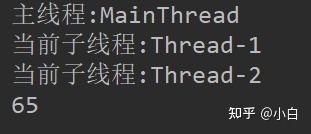一、进程和线程
原文链接:https://zhuanlan.zhihu.com/p/356220352
进程是分配资源的最小单位,线程是系统调度的最小单位。当应用程序运行时最少会开启一个进程,此时计算机会为这个进程开辟独立的内存空间,不同的进程享有不同的空间,而一个CPU在同一时刻只能够运行一个进程,其他进程处于等待状态。
一个进程内部包括一个或者多个线程,这些线程共享此进程的内存空间与资源。相当于把一个任务又细分成若干个子任务,每个线程对应一个子任务。
二、多进程和多线程
对于一个CPU来说,在同一时刻只能运行一个进程或者一个线程,而单核CPU往往是在进程或者线程间切换执行,每个进程或者线程得到一定的CPU时间,由于切换的速度很快,在我们看来是多个任务在并行执行(同一时刻多个任务在执行),但实际上是在并发执行(一段时间内多个任务在执行)。
单核CPU的并发往往涉及到进程或者线程的切换,进程的切换比线程的切换消耗更多的时间与资源。在单核CPU下,CPU密集的任务采用多进程或多线程不会提升性能,而在IO密集的任务中可以提升(IO阻塞时CPU空闲)。可以给CPU密集型任务和IO密集型任务配置一些线程数。CPU密集型:线程个数为CPU核数。这几个线程可以并行执行,不存在线程切换到开销,提高了cpu的利用率的同时也减少了切换线程导致的性能损耗。IO密集型:线程个数为CPU核数的两倍。到其中的线程在IO操作的时候,其他线程可以继续用cpu,提高了cpu的利用率。
而多核CPU就可以做到同时执行多个进程或者多个进程,也就是并行运算。在拥有多个CPU的情况下,往往使用多进程或者多线程的模式执行多个任务。
三、python中的多进程和多线程
1、多进程
def Test(pid): print("当前进程{}:{}".format(pid, os.getpid())) for i in range(1000000000): pass if __name__ == '__main__': #单进程 start = time.time() for i in range(2): Test(i) end = time.time() print((end - start))
添加多线程之后
def Test(pid): print("当前子进程{}:{}".format(pid, os.getpid())) for i in range(100000000): pass if __name__ == '__main__': #多进程 print("父进程:{}".format(os.getpid())) start = time.time() pool = Pool(processes=2) pid = [i for i in range(2)] pool.map(Test, pid) pool.close() pool.join() end = time.time() print((end - start))
从输出结果可以看出都是执行两次for循环,多进程比单进程减少了近乎一半的时间(这里使用了两个进程),并且查看CPU情况可以看出多进程利用了多个CPU。
python中的多进程可以利用mulitiprocess模块的Pool类创建,利用Pool的map方法来运行子进程。一般多进程的执行如下代码:
def Test(pid): print("当前子进程{}:{}".format(pid, os.getpid())) for i in range(100000000): pass if __name__ == '__main__': #多进程 print("父进程:{}".format(os.getpid())) pool = Pool(processes=2) pid = [i for i in range(4)] pool.map(Test, pid) pool.close() pool.join()
1、利用Pool类创建一个进程池,processes声明在进程池中最多可以运行几个子进程,不声明的情况下会自动根据CPU数量来设定,原则上进程池容量不超过CPU数量。(出于资源的考虑,不要创建过多的进程)
2、声明一个可迭代的变量,该变量的长度决定要执行多少次子进程。
3、利用map()方法执行多进程,map方法两个参数,第一个参数是多进程执行的方法名,第二个参数是第二步声明的可迭代变量,里面的每一个元素是方法所需的参数。 这里需要注意几个点:
- 进程池满的时候请求会等待,以上述代码为例,声明了一个容量为2的进程池,但是可迭代变量有4个,那么在执行的时候会先创建两个子进程,此时进程池已满,等待有子进程执行完成,才继续处理请求;
- 子进程处理完一个请求后,会利用已经创建好的子进程继续处理新的请求而不会重新创建进程。
- map会将每个子进程的返回值汇总成一个列表返回。
- 在所有请求处理结束后使用close()方法关闭进程池不再接受请求。
- 使用join()方法让主进程阻塞,等待子进程退出,join()方法要放在close()方法之后,防止主进程在子进程结束之前退出。
2、多线程
python的多线程模块用threading类进行创建
import time import threading import os count = 0 def change(n): global count count = count + n count = count - n def run(n): print("当前子线程:{}".format(threading.current_thread().name)) for i in range(10000000): change(n) if __name__ == '__main__': print("主线程:{}".format(threading.current_thread().name)) thread_1 = threading.Thread(target=run, args=(3,)) thread_2 = threading.Thread(target=run, args=(10,)) thread_1.start() thread_2.start() thread_1.join() thread_2.join() print(count)
程序执行会创建一个进程,进程会默认启动一个主线程,使用threading.Thread()创建子线程;target为要执行的函数;args传入函数需要的参数;start()启动子线程,join()阻塞主线程先运行子线程。 由于变量由多个线程共享,任何一个线程都可以对于变量进行修改,如果同时多个线程修改变量就会出现错误。
上面的程序在理论上的结果应该为0,但运行结果如图4。

出现这个结果的原因就是多个线程同时对于变量修改,在赋值时出现错误,具体解释见多线程解决这个问题就是在修改变量的时候加锁,这样就可以避免出现多个线程同时修改变量。
import time import threading import os count = 0 lock = threading.Lock() def change(n): global count count = count + n count = count - n def run(n): print("当前子线程:{}".format(threading.current_thread().name)) for i in range(10000000): # lock.acquire() # try: change(n) # finally: # lock.release() if __name__ == '__main__': print("主线程:{}".format(threading.current_thread().name)) thread_1 = threading.Thread(target=run, args=(3,)) thread_2 = threading.Thread(target=run, args=(10,)) thread_1.start() thread_2.start() thread_1.join() thread_2.join() print(count)
python中的线程需要先获取GIL(Global Interpreter Lock)锁才能继续运行,每一个进程仅有一个GIL,线程在获取到GIL之后执行100字节码或者遇到IO中断时才会释放GIL,这样在CPU密集的任务中,即使有多个CPU,多线程也是不能够利用多个CPU来提高速率,甚至可能会因为竞争GIL导致速率慢于单线程。所以对于CPU密集任务往往使用多进程,IO密集任务使用多线程。
四、多核并行计算
原文链接:https://blog.csdn.net/ctwy291314/article/details/89358144
1.多进程库 Multiprocessing
import math import datetime import multiprocessing as mp def train_on_parameter(name, param): result = 0 for num in param: result += math.sqrt(num * math.tanh(num) / math.log2(num) / math.log10(num)) return {name: result} if __name__ == '__main__': start_t = datetime.datetime.now() num_cores = int(mp.cpu_count()) print("本地计算机有: " + str(num_cores) + " 核心") pool = mp.Pool(num_cores) param_dict = {'task1': list(range(10, 30000000)), 'task2': list(range(30000000, 60000000)), 'task3': list(range(60000000, 90000000)), 'task4': list(range(90000000, 120000000)), 'task5': list(range(120000000, 150000000)), 'task6': list(range(150000000, 180000000)), 'task7': list(range(180000000, 210000000)), 'task8': list(range(210000000, 240000000))} results = [pool.apply_async(train_on_parameter, args=(name, param)) for name, param in param_dict.items()] results = [p.get() for p in results] end_t = datetime.datetime.now() elapsed_sec = (end_t - start_t).total_seconds() print("多进程计算 共消耗: " + "{:.2f}".format(elapsed_sec) + " 秒")
- 核心数量: cpu_count() 函数可以获得你的本地运行计算机的核心数量。如果你购买的是 Intel i7或者以上版本的芯片,你会得到一个乘以2的数字,得益于超线程 (Hyper-Threading) 结构,Python 可利用核心数量是真实数量的2倍!所以我在前文中会建议Python开发者购买 i7 而不是 第八代之前的 i5。
- 进程池: Pool() 函数创建了一个进程池类,用来管理多进程的生命周期和资源分配。这里进程池传入的参数是核心数量,意思是最多有多少个进程可以进行并行运算。
- 异步调度: apply_async() 是进程池的一个调度函数。第一个参数是计算函数,和 多多教Python:Python 基本功: 13. 多线程运算提速 里多线程计算教程里创建线程的参数 target 类似。第二个参数是需要传入计算函数的参数,这里传入了计算函数名字和计算调参。而异步的意义是在调度之后,虽然计算函数开始运行并且可能没有结束,异步调度都会返回一个临时结果,并且通过列表生成器 (参考: 多多教Python:Python 基本功: 12. 高纬运算的救星 Numpy) 临时的保存在一个列表里,这里就是 results。
- 调度结果: 如果你检查列表 results 里的类,你会发现 apply_async() 返回的是 ApplyResult,也就是调度结果类。这里用到了 Python 的异步功能,目前教程还没有讲到,简单的来说就是一个用来等待异步结果生成完毕的容器。
- 获取结果: 调度结果 ApplyResult 类可以调用函数 get(), 这是一个非异步函数,也就是说 get() 会等待计算函数处理完毕,并且返回结果。这里的结果就是计算函数的 return。
2.并行计算
多线程因为共享一个进程的内存,所以在并行计算的时候会出现资源竞争的问题,这个在多多教Python:Python 基本功: 13. 多线程运算提速 已经提到过。而多进程虽然避免了这个问题,但是无法像多线程一样轻易的调用一个内存的资源。为了能让多进程之间进行通讯 (IPC),Python 的 Multiprocessing 库提供了几种方案: Pipe, Queue 和 Manager。这里 Pipe 我就直接引用一个外部我觉得很简单明了的介绍,Queue 有兴趣的小伙伴可以在教程结尾找到外部的链接,然后我会在之前的例子中加入 Manager。
管道Pipe:
Pipe可以是单向(half-duplex),也可以是双向(duplex)。我们通过mutiprocessing.Pipe(duplex=False)创建单向管道 (默认为双向)。一个进程从PIPE一端输入对象,然后被PIPE另一端的进程接收,单向管道只允许管道一端的进程输入,而双向管道则允许从两端输入。
import multiprocessing as mul def proc1(pipe): pipe.send('hello') print('proc1 rec:', pipe.recv()) def proc2(pipe): print('proc2 rec:', pipe.recv()) pipe.send('hello, too') # Build a pipe pipe = mul.Pipe() if __name__ == '__main__': # Pass an end of the pipe to process 1 p1 = mul.Process(target=proc1, args=(pipe[0],)) # Pass the other end of the pipe to process 2 p2 = mul.Process(target=proc2, args=(pipe[1],)) p1.start() p2.start() p1.join() p2.join()
管理员 Manager
Manager 是一个 Multiprocessing 库里的类,用来创建可以进行多进程共享的数据容器,容器种类包括了几乎所有 Python 自带的数据类。
import math import datetime import multiprocessing as mp def train_on_parameter(name, param, result_dict, result_lock): result = 0 for num in param: result += math.sqrt(num * math.tanh(num) / math.log2(num) / math.log10(num)) with result_lock: result_dict[name] = result return if __name__ == '__main__': start_t = datetime.datetime.now() num_cores = int(mp.cpu_count()) print("本地计算机有: " + str(num_cores) + " 核心") pool = mp.Pool(num_cores) param_dict = {'task1': list(range(10, 30000000)), 'task2': list(range(30000000, 60000000)), 'task3': list(range(60000000, 90000000)), 'task4': list(range(90000000, 120000000)), 'task5': list(range(120000000, 150000000)), 'task6': list(range(150000000, 180000000)), 'task7': list(range(180000000, 210000000)), 'task8': list(range(210000000, 240000000))} manager = mp.Manager() managed_locker = manager.Lock() managed_dict = manager.dict() results = [pool.apply_async(train_on_parameter, args=(name, param, managed_dict, managed_locker)) for name, param in param_dict.items()] results = [p.get() for p in results] print(managed_dict) end_t = datetime.datetime.now() elapsed_sec = (end_t - start_t).total_seconds() print("多线程计算 共消耗: " + "{:.2f}".format(elapsed_sec) + " 秒")
这里我们用 Manager 来创建一个可以进行进程共享的字典类,随后作为第三个参数传入计算函数中。计算函数把计算好的结果保存在字典里,而不是直接返回。在并行运算结束之后,我们通过 print() 函数来查看字典里的结果。注意这里既然出现了可以共享的数据类,我们就要再次通过锁 (Lock) 来避免资源竞争,所以同时通过 Manager 创建了锁 Lock 类,以第四个参数传入计算函数,并且用 With 语境来锁住共享的字典类。





【推荐】国内首个AI IDE,深度理解中文开发场景,立即下载体验Trae
【推荐】编程新体验,更懂你的AI,立即体验豆包MarsCode编程助手
【推荐】抖音旗下AI助手豆包,你的智能百科全书,全免费不限次数
【推荐】轻量又高性能的 SSH 工具 IShell:AI 加持,快人一步
· AI与.NET技术实操系列:向量存储与相似性搜索在 .NET 中的实现
· 基于Microsoft.Extensions.AI核心库实现RAG应用
· Linux系列:如何用heaptrack跟踪.NET程序的非托管内存泄露
· 开发者必知的日志记录最佳实践
· SQL Server 2025 AI相关能力初探
· 震惊!C++程序真的从main开始吗?99%的程序员都答错了
· winform 绘制太阳,地球,月球 运作规律
· 【硬核科普】Trae如何「偷看」你的代码?零基础破解AI编程运行原理
· 上周热点回顾(3.3-3.9)
· 超详细:普通电脑也行Windows部署deepseek R1训练数据并当服务器共享给他人